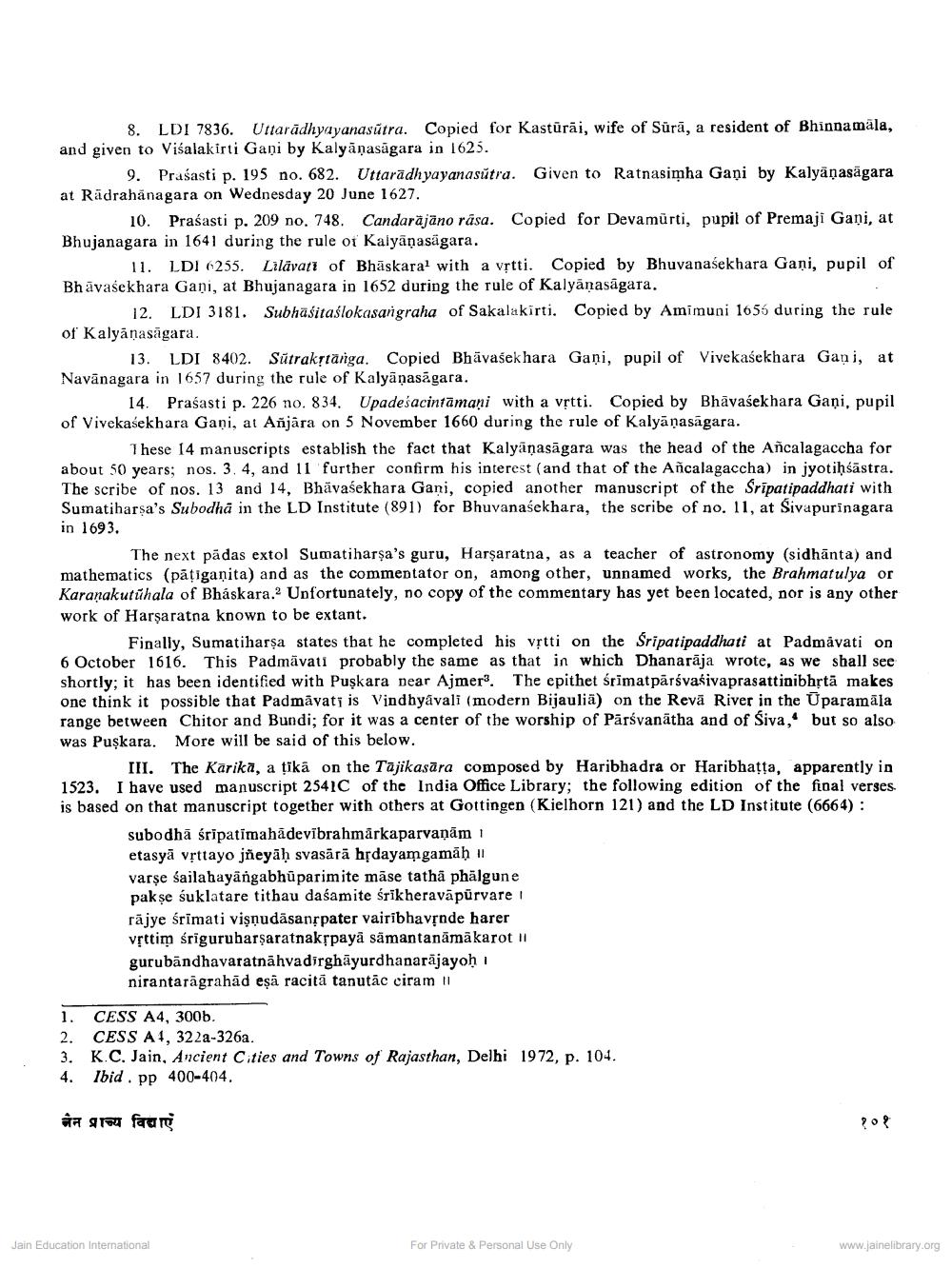________________
8. LDI 7836. Uttarādhyayanasūtra. Copied for Kastūrāi, wife of Sürā, a resident of Bhinnamala, and given to Visalakirti Gaņi by Kalyānasāgara in 1625.
9. Prasasti p. 195 no. 682. Uttarādhyayanasútra. Given to Ratnasimha Gaņi by Kalyāṇasāgara at Rädrahănagara on Wednesday 20 June 1627.
10. Prasasti p. 209 no. 748. Candarājāno rāsa. Copied for Devamurti, pupil of Premaji Gani, at Bhujanagara in 1641 during the rule of Kalyaņasägara.
11. LDI (255. Lilävart of Bhāskaral with a vștti. Copied by Bhuvanasekhara Gani, pupil of Bhāvasekhara Gani, at Bhujanagara in 1652 during the rule of Kalyānasagara.
12. LDI 3181. Subhasitaślokasangraha of Sakalakirti. Copied by Amimuni 1656 during the rule of Kalyānasāgara.
13. LDI 8402. Sūtrakstanga. Copied Bhāvasekhara Gaņi, pupil of Vivekasekhara Gani, at Navānagara in 1657 during the rule of Kalyäņasāgara.
14. Prašasti p. 226 no. 834. Upadešacintāmani with a vrtti. Copied by Bhāvasekhara Gani, pupil of Vivekasekhara Gani, at Añjara on 5 November 1660 during the rule of Kalyānasāgara.
These 14 manuscripts establish the fact that Kalyāṇasāgara was the head of the Ancalagaccha for about 50 years; nos. 3. 4, and 11 further confirm his interest (and that of the Ancalagaccha) in jyotiḥśāstra. The scribe of nos. 13 and 14, Bhāvašekhara Gani, copied another manuscript of the Sripatipaddhati with Sumatiharsa's Subodha in the LD Institute (891) for Bhuvanasekhara, the scribe of no. 11, at Sivapurinagara in 1693.
The next pādas extol Sumatiharşa's guru, Harṣaratna, as a teacher of astronomy (sidhānta) and mathematics (pātiganita) and as the commentator on, among other, unnamed works, the Brahmatulya or Karanakutūhala of Bhaskara. Unfortunately, no copy of the commentary has yet been located, nor is any other work of Harsaratna known to be extant.
Finally, Sumatiharsa states that he completed his vrtti on the Sripatipaddhati at Padmavati on 6 October 1616. This Padmavati probably the same as that in which Dhanarāja wrote, as we shall see shortly; it has been identified with Puşkara Dear Ajmer). The epithet śrīmatpārsvasivaprasattinibhṛtā makes one think it possible that Padmavati is Vindhyávali (modern Bijaulia) on the Revā River in the Ūparamāla range between Chitor and Bundi; for it was a center of the worship of Pārsvanātha and of Siva,' but so also was Puşkara. More will be said of this below.
III. The Karika, a tikä on the Tajikasāra composed by Haribhadra or Haribhatta, apparently in 1523. I have used manuscript 2541C of the India Office Library; the following edition of the final verses is based on that manuscript together with others at Gottingen (Kielhorn 121) and the LD Institute (6664):
subodhā sripatimahadevibrahmárkaparvaņām 1 etasyā vrttayo jñeyāḥ svasarā hşdayamgamaḥ Il varse śailahayāngabhūparimite māse tatha phālgune pak se suklatare tithau daśamite srikherava pūrvare räjye śrimati vişnudāsanrpater vairibhavsnde harer vsttim brigurubarsaratnakrpayā samantanämäkarot 11 gurubāndhavaratnähvadirghāyurdhanarājayoḥ nirantarāgrahād esa racitä tanutác ciram 11
1. CESS A4, 300b. 2. CESS A+, 322a-326a. 3. K.C. Jain, Ancient Cities and Towns of Rajasthan, Delhi 1972, p. 104. 4. Ibid. pp 400-404.
मैन प्राच्य विद्याएं
Jain Education International
For Private & Personal Use Only
www.jainelibrary.org




